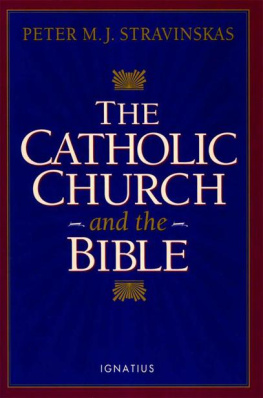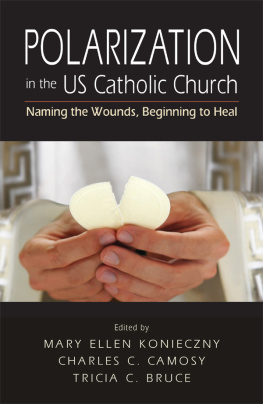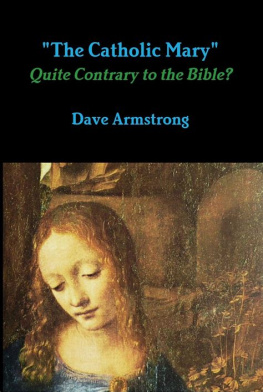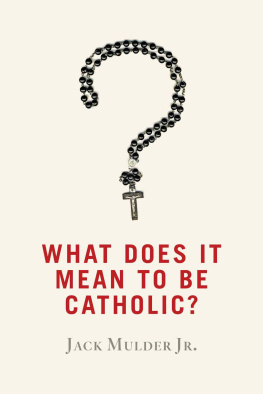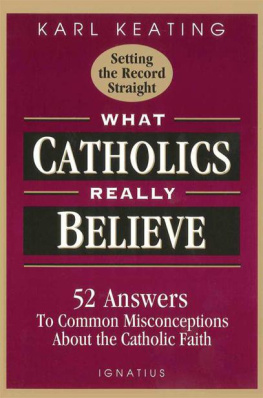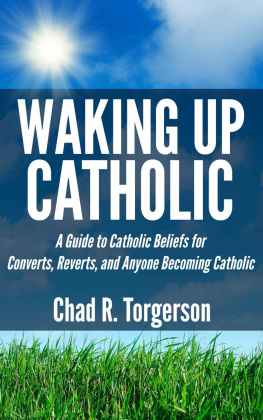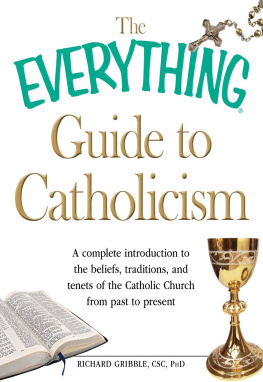What Mary Means to Christians
An Ancient Tradition Explained
Reverend Peter M. J.Stravinskas

Paulist Press
New York / Mahwah, NJ
The Scripture quotations contained herein are from the Revised Standard Version: Catholic Edition. Copyright 1946, 1952, 1957, 1965, 1966, 2006 by the Division of Christian Education of the National Council of the Churches of Christ in the USA. Used by permission. All rights reserved.
Cover image: Copyright by Zvonimir Atletic / Shutterstock.com
Cover design by Sharyn Banks
Book design by Lynn Else
Copyright 2012 by Rev. Peter M. J. Stravinskas
All rights reserved. No part of this book may be reproduced or transmitted in any form or by any means, electronic or mechanical, including photocopying, recording, or by any information storage and retrieval system without permission in writing from the Publisher.
Library of Congress Cataloging-in-Publication Data
Stravinskas, Peter M. J.
What Mary means to Christians : an ancient tradition explained / Peter M. J. Stravinskas.
p. cm.
Includes bibliographical references.
ISBN 978-1-61643-048-1 1. Mary, Blessed Virgin, Saint. I. Title.
BT603.S77 2012
232.91dc23
2011033018
Published by Paulist Press
997 Macarthur Boulevard
Mahwah, New Jersey 07430
www.paulistpress.com
Contents
Do Catholics worship Mary and the other saints?
Catholics are often insulted by this question and frequently refuse to answer it for that reason alone. A nonresponse, however, is not helpful for a variety of reasons, not least of which is that it is an extremely important questionthe answer to which determines whether one is a Christian.
The relationship between Catholics and Mary mystifies many non-Catholic Christians, and Catholics are equally mystified by their strange silence about hera silence that is awkward and uncomfortable, a silence that is usually broken only once a year at Christmastime because ancient carols force believers to acknowledge and sing of the Virgin who became the Mother of the Messiah. Of course, not all non-Catholic Christians fall into this category: Eastern Orthodox devotion to the Mother of God is very strong, many Anglicans and Lutherans share our convictions about the Blessed Virgin, and one of the best books on the Rosary was written by a Methodist minister. By and large, though, Protestants have not followed the example of John the Beloved Disciple by making room in their homes for the Mother of Our Lord (John 19:27). It may also surprise some readers to learn that Islam holds Our Lady in great reverence; in fact, there are more references to Mary in the Koran than in the New Testament!
Catholics need to become better spokespersons for Marian devotion, both in their articulation of it and in their understanding of its scriptural basis. In many circumstances, an honest dialogue brings to light that the problem of many non-Catholics with Mary is not so much Mary herself as the way she is presented. Such people need to be challenged forthrightly and charitably to think about Mary and to reflect on their usual silence (and even hostility) in her regard. Our goal should not be to rouse their sensibilities to the heights of Marian devotion, but to raise their consciousness to an appreciation of the role of the Blessed Virgin in her Sons work of salvation.
The teaching of the Scriptures and the Church is clear: Jesus Christ is the sole Mediator between God and man (1 Tim 2:5). No other person in Heaven or on Earth can take His place. The role of every saint is to lead the believer to Christ. This subordinate form of mediation derives its meaning and effectiveness from the Lord Himself and is not something the saints possess on their own.
Where, then, does Mary fit into the picture?
Catholics look on Mary, above all, as a model and guide. By her yes to the will of the Father at the Annunciation, Mary became the first and best Christian ever to live. Her life is a testimony to the wonderful things that can happen when the human person cooperates with the divine plan. In agreeing to be the human vessel that brought the Messiah into the world, the Blessed Mother played an essential part in Christs salvific mission. She manifested Christian humility and obedience when she responded to Gods will: Behold, I am the handmaid of the Lord; let it be to me according to your word (Luke 1:38). Her faith in God and her response to His will mark Mary as the first human being to accept Christ, body and soul, as she welcomed Him into her very self. The Church ever since echoes the words of Marys kinswoman Elizabeth, as she proclaimed: And blessed is she who believed that there would be a fulfillment of what was spoken to her from the Lord (Luke 1:45).
Let me state at the outset what this book is not. It is not intended to be a comprehensive Mariological treatise; nor is it exclusively devotional in character. I have tried to produce a work that will serve a number of purposes for the average well-educated and devout Catholic. And so, we shall be looking at the figure of Our Lady, first of all, through the Sacred Scriptures, but also from doctrinal and liturgical perspectives. As already mentioned, there is an apologetical dimension to our considerations, that is, a conscious effort to present Marian doctrine and devotion in a manner that is biblically rooted and theologically sound, and thus comprehensible to those for whom this is often seen as dangerous territorywhich likewise makes this work a contribution to ecumenical dialogue, for genuine dialogue can only occur when misunderstandings are cleared away.
Each meditation closes with some thoughts from a great English convert of the nineteenth century, John Henry Cardinal Newman. Why Newman, one might ask? Several reasons suggest themselves. First of all, the case has been made by many that Blessed Cardinal Newman may well have been the most important theologian writing in English in the past several centuries. Indeed, every pope of the twentieth century envisioned him a Doctor of the Church, should he be canonized, which leads to the second point. While I was working on this text, I was inspired by Newmans then-pending beatification, the penultimate step to canonization. Most significant, that ceremony was presided over by Pope Benedict himself (despite his personal policy to delegate beatifications to lower levels of the hierarchy) because of his belief that Newman has such a universal value. Third, as a Protestant, Newman was thoroughly hostage to what we can call Marian neuralgia. One of the first results of his intensive study of the Fathers of the Church, however, was being cured of this neuralgia, so that he becameeven while still a Protestanta Marian apologist. The excerpts from his writings on Our Lady are broad-ranging: from sermons, to letters, to treatises, written over decades, both before and after his entrance into full communion with the Catholic Church. A word of warning is in order, namely, that Newman is not a G. K. Chesterton or a Fulton J. Sheen, known for short, pithy, one-liners. He can be dense, but probing his writing is well worth the effort to experience the depth, tenderness, and beauty of his thoughts on the Mother of God.
At Newmans Mass of Beatification in Birmingham, England, celebrated on September 19, 2010, the Holy Father led into his Sunday Angelus address with the following reflection on Blessed John Henrys Mariology:
When Blessed John Henry Newman came to live in Birmingham, he gave the name Maryvale to his first home here. The Oratory that he founded is dedicated to the Immaculate Conception of the Blessed Virgin. And the Catholic University of Ireland he placed under the patronage of Mary, Sedes Sapientiae
Next page

